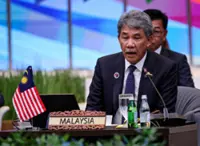Power play: Crew members of the ‘USS Nimitz’ watching a F/A-18E Super Hornet fighter jet preparing to take off on a routine flight. — Reuters
ABOARD THE NIMITZ: Over a few hours under grey skies, dozens of combat planes and helicopters roar on and off the flight deck of the aircraft carrier Nimitz, in a demonstration of US military power in some of the world’s most hotly contested waters.
MH-60 Seahawk helicopters and F/A-18 Hornet jets bearing pilot call signs like “Fozzie Bear”, “Pig Sweat” and “Bongoo” emit deafening screams as they land in the drizzle on the Nimitz, which is leading a carrier strike group that entered the South China Sea two weeks ago.





